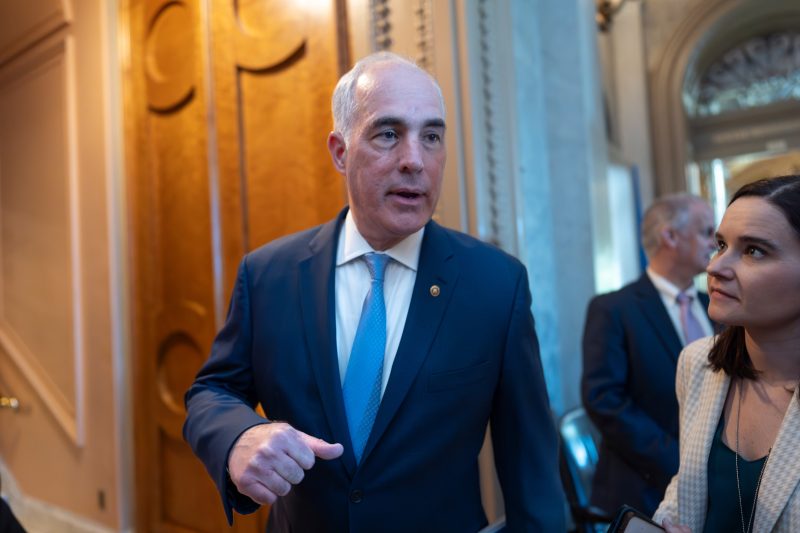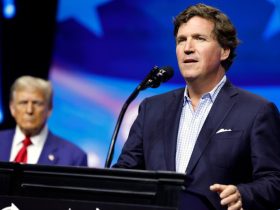For almost six months, Democrats struggled with a strange paradox in which President Biden lagged behind in critical states while their Senate candidates built clear leads in those same battlegrounds.
Even after Biden’s disastrous debate performance at the end of June, Sen. Bob Casey (D-Pa.) had an 11 percentage-point lead over his GOP foe, David McCormick, in mid-July, doubling his advantage from a New York Times poll from two months earlier. Biden trailed former president Donald Trump, 48 to 45.
The same polling outfit found Sen. Tim Kaine (D-Va.) with a resounding 18-point lead last week over his little-known opponent, as Biden had drifted down into a statistical tie with Trump.
Now, with Biden stepping aside and Vice President Harris taking the mantle as the likely nominee, Democrats will find out whether the president’s struggle with voters this year was something unique to him and his frailty. Polling has been a bit uneven since Biden’s withdrawal on Sunday, but several surveys seem to suggest that the vice president has energized Democrats and pulled back some voters who had preferred a third-party choice rather than Biden.
Democrats believe their message and their campaigns were properly structured, but that their messenger had his own unique flaws. Democrats are betting that Harris, 59, can re-energize a liberal coalition that has delivered popular-vote victories in four straight presidential elections and replicate their defeat of Trump four years ago.
“I have never seen such a quick reversal of an emotional state. The anti-Trump coalition was just waiting to be reactivated. We are back,” Sen. Brian Schatz (D-Hawaii) said after Harris and allies raised $250 million in two days.
Rep. Chrissy Houlahan (D-Pa.), an early Biden endorser in 2020, cited the June 27 debate as “the pivot point” from which Democrats could not escape questions about the president’s ability to serve another four years.
“We as Democrats have an enormous record to run on,” Houlahan said in an interview, saying those accomplishments got drowned out by voter perceptions of the 81-year-old incumbent’s ability to perform the job.
“We were constantly talking about the debate,” she added.
With Harris at the top of the ticket, Democrats hope the gloomy issue of Biden’s age will fade or even shift onto the backs of GOP candidates supporting the 78-year-old Trump, with his own questions about fitness to serve into 2029.
“We can talk about the future,” Schatz said, accusing Republicans of a social policy agenda that would take America back to “the late 1950s.”
Republicans dismiss the argument that Biden was the only thing dragging down Democrats as overly hyped. They argue that overlooks how poorly voters viewed Biden’s handling of key issues such as inflation and the border for several years before his debate debacle last month.
“Obviously, Biden’s age and everything were pulling down his support, but the policies that he embraced are the same policies that Harris has embraced,” Sen. John Cornyn (R-Tex.) told reporters on Tuesday.
Cornyn, who is running to be Senate Republican leader next year, said he would welcome a campaign that was less of a “personality race” and focused more on those policy issues.
Yet for almost a year, GOP challengers have pounded away at Democratic candidates in those same battleground states on those issues, with only marginal impact so far.
In Pennsylvania, both Casey and McCormick have been airing television ads steadily since the early spring. Their campaigns spent a combined $18 million in the second quarter, with Casey holding an almost 2-to-1 edge, but outside super PACs are also flooding the airwaves.
After McCormick won his primary in late April, the race had closed to a narrow 46-41 lead for the Democratic incumbent, according to the Times-Sienna poll. That grew to Casey receiving 50 percent against McCormick’s 39 percent in their poll released last week.
Other, less reliable polls showed Casey with leads in a similar range after Biden’s debate flop.
Meanwhile, Pennsylvanians have remained sour on Biden almost the entire year, favoring Trump 47 to 44 percent in the early May poll and almost identically 48 to 44 percent after the debate.
Kaine saw a similar development in his race. “After the debate, for some weird reason, I’m going up and [the presidential race] went back to a dead head,” he said Wednesday.
In Wisconsin, as Biden’s numbers moved up a bit in the spring into a narrow lead and then down again after the debate, Sen. Tammy Baldwin (D-Wis.) has maintained a steady lead over her GOP foe of about 5 percentage points or more.
The Marquette poll, considered the state’s most reliable, showed that 41 percent of voters had a favorable view of Baldwin in the fall, versus 43 percent that viewed her unfavorably. By mid-June, after millions had been spent trying to tarnish her image, Baldwin’s favorability ratings had climbed to 45 to 44 percent unfavorable.
That poll gave her a nine-point lead among likely voters, as independents favored her by 4 percentage points against banking executive Eric Hovde. Biden trailed Trump by 16 percentage points among independents in a head-to-head match.
Democratic advisers working on Senate races said the most competitive races mirrored the relative steadiness of Democratic candidates in Pennsylvania, Virginia and Wisconsin, despite Biden’s own decline in many of these states.
The Democratic Congressional Campaign Committee, in a memo about the state of the race for the House majority, said that its top-priority incumbents in competitive districts — called “Frontliners” — had also maintained a political resiliency throughout the tumultuous spring and summer.
They held steady leads into mid-July, along with top Democratic challengers to GOP House incumbents, according to the DCCC, which said it had “no poll showing atrophy in their support” after the debate.
Democrats privately acknowledged that some states that have been steadily turning blue in recent elections — Biden won Colorado, Minnesota, New Mexico and Virginia by a range of 7 to 13 points — had instead become quite competitive in the 2024 cycle.
And in some of those down-ballot races, incumbents such as Sen. Martin Heinrich (D-N.M.), where the race has been slower to develop, began to see erosion in their standing back home.
Democrats feared a similar dynamic was setting in for their relatively safe incumbents, who have not been running with the same level of intensity as the front-line lawmakers. In the debate aftermath, those Democrats started facing a tougher path to victory.
“Most people were experiencing a dip of sorts,” said Houlahan, whose suburban Philadelphia district went from a battleground in 2018 to a likely Democratic seat.
Senate Republicans have repeatedly told themselves to set their expectations properly ever since Democratic incumbents won every race two years ago.
“These candidates, these incumbents, have their own name ID and being an incumbent is a pretty powerful position to run from,” Cornyn said.
The key test in the weeks ahead will be whether Harris can position herself along the lines of those battle-tested incumbents like Casey and Baldwin, or if Republicans can turn her into another version of the unpopular Biden.
Republicans want to keep voters focused on inflation and the Southern border in key states, making Harris answer for what they see as Biden’s failings, Cornyn said. “Those are going to be, I think, a real drag on her candidacy.”
And Schatz has a lingering fear that, despite the quick unity around Harris, certain ideological factions will issue purity tests on liberal policy that are unpopular with undecided voters in key swing states.
“There will be plenty of time for those arguments. None of that is possible if you lose,” Schatz said.
But Democrats are at least relieved they won’t have to answer for Biden’s debate performance and an age issue that hung over the campaign for this entire year.
Schatz, 51, who remained a steadfast Biden supporter until this month, said that the issue “never stopped” and crept into all of the other issues the president faced.
It left Democrats perpetually on defense.
“When you’re explaining, you’re losing,” Schatz said, “and we were doing a lot of explaining.”










